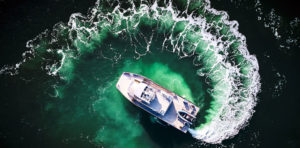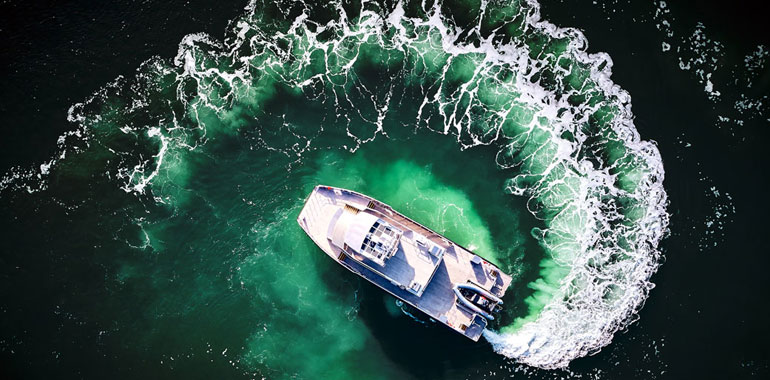
It’s a cat-and-mouse game on the high seas: Unlicensed commercial fishermen from Mexico head north into Texas waters in small, swift boats called “lanchas,” hoping to catch a haul of seafood before the authorities catch them.
One day this summer, the crew of one such fishing boat saw something unusual. Heading toward them was a sleek silver vessel boldly marked with the words “Texas Game Warden.”
It was Captain Murchison, an 80-foot aluminum catamaran with a maximum speed of 27 knots. When it’s running fast, the hydrofoil between its twin hulls lifts the bow partially out of the water.
The game wardens requested over a loudspeaker, both in English and Spanish, for the fishing vessel to stop. “It quickly did, because they were shocked. They had never seen a vessel like that before, as capable and maneuverable as it was,” said Cody Jones, an assistant commander with the Texas Parks and Wildlife Department.
The wardens had a chance to talk with the fishing crew. “They mentioned to one of the game wardens that they knew they couldn’t outrun it, so they just gave up,” Jones recalled. Captain Murchison caught another illegal fishing crew the next day.
These interdictions are among the notable moments so far in the career of Captain Murchison, a high-powered patrol craft that is now the flagship vessel for the law enforcement division of the Texas Parks and Wildlife Department, also known as the Texas Game Wardens.
Based in South Padre Island near the U.S.-Mexico border, Captain Murchison’s mission is to work with the U.S. Coast Guard to enforce fishing laws and to stop any other illegal activity the crew might encounter.
Texas has nearly 3,400 miles of shoreline, and state waters extend 9 nautical miles into the Gulf of Mexico. The state’s game wardens can work up to 200 miles into the Gulf through an agreement with the National Oceanic and Atmospheric Administration (NOAA) to protect federal fisheries, as fishermen from Mexico will sometimes venture into U.S. waters without permission.
For decades, Texas Game Wardens have worked to stop exploitation of these sea resources. Historically, the agency has had three long-range boats. Two were purchased in the early 1980s, Jones said. One was Captain Williams, and the other boat was the original Captain Murchison.
The new Captain Murchison, like the first, is named for Dawson Murchison, a game warden shot and killed in 1938 while patrolling King Ranch for poachers. The original patrol boat was about 65 feet long, smaller than today’s 80-foot vessel, Jones said.
It also wasn’t specifically built for law enforcement purposes. Case in point: If the pilot of the original Captain Murchison wanted to board a vessel that the crew suspected was fishing unlawfully, the pilot had to back up to the suspect vessel, stern to stern. This was not only inefficient, but dangerous. Jones said that over the years, some game wardens were hurt doing the ship-to-ship jump.
Following a bid process, the Texas Parks and Wildlife Department awarded the construction contract to All American Marine Inc. of Bellingham, Wash. The agency and the boatbuilder worked together to create a custom-made vessel.
“Well, they were looking for additional speed. They were looking for fuel economy. And they were looking for comfort, stability,” said Ron Wille, business development manager at All American Marine.
These requirements led to a catamaran design enhanced with a hydrofoil. When the boat is moving fast, its bow lifts out of the water, reducing drag and increasing fuel efficiency. The catamaran hull also reduces the rolling of the boat, increasing comfort for those on board, Wille said.
To avoid the dangerous stern-to-stern boarding maneuver, the boat’s bow was redesigned. Now, Captain Murchison’s pilot can steer the vessel bow-first into a suspect boat for boarding.
“You can pull the gates back on the bow of the boat, and with the push knees that were built into this boat, a game warden can literally walk off onto the shrimp boat without having to time jumps or any of that craziness,” Jones said.
The contract was signed Jan. 10, 2019, and the boat was launched exactly one year later, Wille said. The Texas Legislature had originally appropriated $4 million for the project. The state agency would end up appropriating $750,000 more than the original budget.
“I can tell you, for what we paid — $4.75 million — the $750,000 we spent was well worth it,” Jones said. “All American did a fantastic job of really setting us up properly.”
Transporting Captain Murchison from the shipyard to its new home was a bit of an adventure. First, the Texas Game Wardens sent a crew to Washington to pilot the brand-new boat south toward the Panama Canal. But the agency lacked the permits it needed to bring the boat through the canal on its own, he said.
So, they looked for a yacht carrier — a bigger ship that could carry the boat through the canal. They met up with such a ship in Ensenada, Mexico, where Captain Murchison was hauled aboard and later offloaded in Fort Lauderdale, Fla. The game wardens got it home to South Padre Island on the morning of March 25.
Captain Murchison is built for stalking, chasing and boarding boats whose crews are trying to evade law enforcement. Powering its 27-knot speed are twin Caterpillar C18 ACERT D engines, combined with HamiltonJet HM521 waterjets through ZF Marine reduction gears. N C Power supplied the Cat engines.
The vessel is the first in North America outfitted with HamiltonJet’s Advanced Vessel Control (AVX) suite. The system combines stationkeeping technology with the company’s JETanchor positioning system. “You press a button and it really holds you right there, within inches,” Jones said. “In fact, you can pull into a very tight marina, press that, and you aren’t going to go anywhere close to the docks.”
Also installed on the new patrol boat is an Axiom Pro navigation and video monitoring system from Raymarine, which integrates camera input alongside radar and chartplotter displays.
“I can turn on the camera and click on a vessel that I see on my screen,” Jones said. “The camera will track that vessel, it will put the name of that vessel from the AIS … over that vessel on the screen. It will plot me an intercept course.” The camera can also lock onto small fishing vessels that don’t stand out on traditional radar systems. The system is equipped with a FLIR high-resolution thermal imaging video camera.
With the touch of a button, the pilot can launch a DJI Mavic drone that immediately starts transmitting video back to the boat. This allows for an early view of a suspect vessel, which can help law enforcement determine if it’s safe to board. The video can also be relayed to an onshore command center, and may later serve as evidence in future legal proceedings.
Among Captain Murchison’s other notable features is the Teknicraft Rapid RHIB launching system. It’s meant for use in tactical situations where a second craft would help — for instance, to assist during a pursuit or to approach a damaged boat.
On most ships, such a boat has to be launched with a crane, according to Wille from All American. “And so a boat has to literally stop, fire up the crane, unlatch the (rigid-hull inflatable boat), pick it up, put it in the water and then get in,” he said. “And by that time, you know, in the case of Texas, the bad guys are long gone.”
By contrast, the Teknicraft system can launch an RHIB off the stern of Captain Murchison in less than a minute. The 20-foot Willard Marine Sea Force 540 RHIB is capable of 32 knots thanks to a single 170-hp Volvo D3 engine driving a HamiltonJet HJ213 waterjet
The patrol vessel has three standing posts — one at the bow, and one at each side of the stern. When the boat is on its normal wildlife patrols, those posts mount a reel-and-winch system for reeling in longline fishing setups.
“We can put the band and reel in those posts and be able to pull the miles and miles of long line with little effort, when we would historically do it by hand,” Jones said.
Those standing posts can also serve another purpose: Occasionally, Captain Murchison is used to escort aging aircraft carriers into the Port of Brownsville for decommissioning, and for that, the standing posts hold M240B machine guns.
The boat typically has a crew of six. Its current pilot is Sgt. Jason Duke of the Texas Game Wardens, who formerly piloted Captain Williams. Accompanying him is Greg Bowers-Vest, a civilian employee who serves as mechanic, deck hand and all-around helper.
The two permanent crewmembers are joined each week by a rotating crew of game wardens who come on board for five-day missions out of South Padre Island. They stay in three crew staterooms, each with double bunks equipped with individual lights, plugs and closets. The boat has a full galley, head and shower.
Those comforts served the crew well as they venture far from shore. One notable patrol so far was a journey deep into the Gulf of Mexico to the Flower Garden Banks, a U.S. National Marine Sanctuary of protected reefs.
“Our general responsibility is taking care of the wild things and wild places,” Jones said. “And it meets what we need.” •

